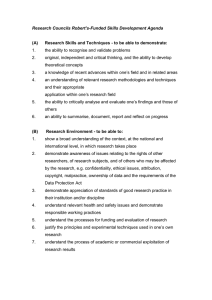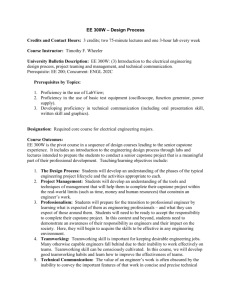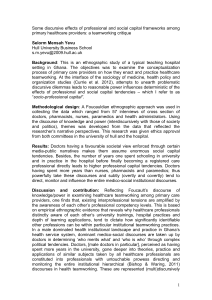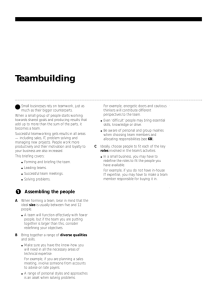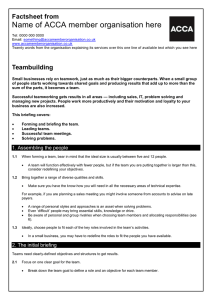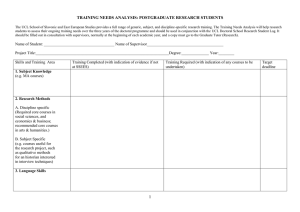Teamworking (M010)
advertisement
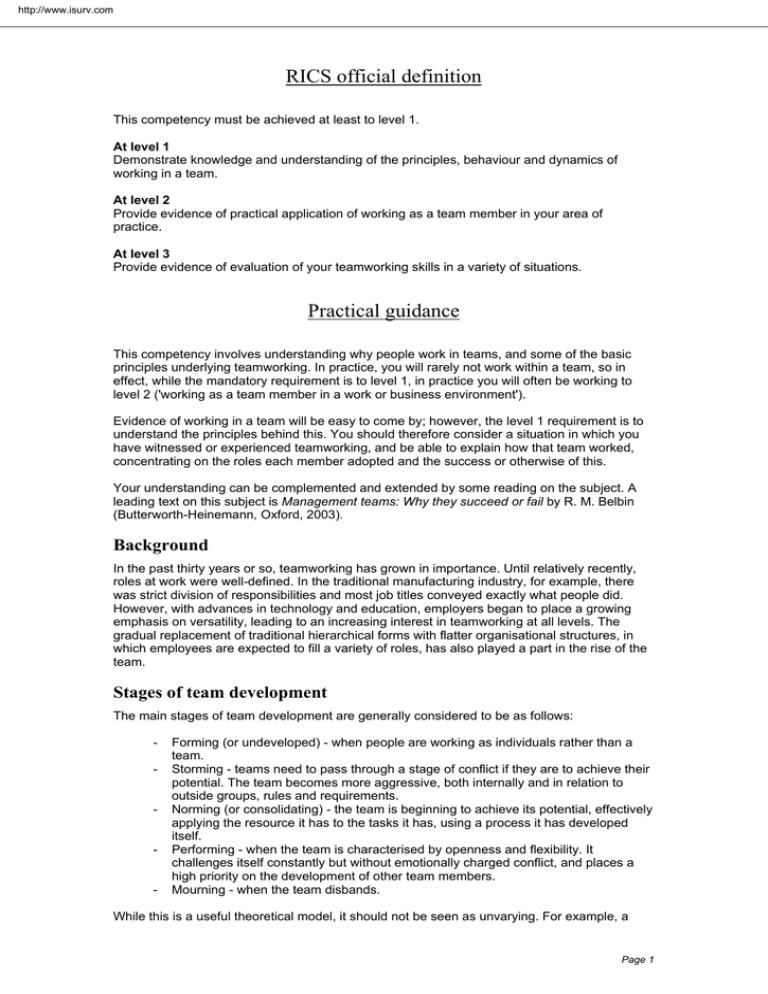
http://www.isurv.com
RICS official definition
This competency must be achieved at least to level 1.
At level 1
Demonstrate knowledge and understanding of the principles, behaviour and dynamics of
working in a team.
At level 2
Provide evidence of practical application of working as a team member in your area of
practice.
At level 3
Provide evidence of evaluation of your teamworking skills in a variety of situations.
Practical guidance
This competency involves understanding why people work in teams, and some of the basic
principles underlying teamworking. In practice, you will rarely not work within a team, so in
effect, while the mandatory requirement is to level 1, in practice you will often be working to
level 2 ('working as a team member in a work or business environment').
Evidence of working in a team will be easy to come by; however, the level 1 requirement is to
understand the principles behind this. You should therefore consider a situation in which you
have witnessed or experienced teamworking, and be able to explain how that team worked,
concentrating on the roles each member adopted and the success or otherwise of this.
Your understanding can be complemented and extended by some reading on the subject. A
leading text on this subject is Management teams: Why they succeed or fail by R. M. Belbin
(Butterworth-Heinemann, Oxford, 2003).
Background
In the past thirty years or so, teamworking has grown in importance. Until relatively recently,
roles at work were well-defined. In the traditional manufacturing industry, for example, there
was strict division of responsibilities and most job titles conveyed exactly what people did.
However, with advances in technology and education, employers began to place a growing
emphasis on versatility, leading to an increasing interest in teamworking at all levels. The
gradual replacement of traditional hierarchical forms with flatter organisational structures, in
which employees are expected to fill a variety of roles, has also played a part in the rise of the
team.
Stages of team development
The main stages of team development are generally considered to be as follows:
-
Forming (or undeveloped) - when people are working as individuals rather than a
team.
Storming - teams need to pass through a stage of conflict if they are to achieve their
potential. The team becomes more aggressive, both internally and in relation to
outside groups, rules and requirements.
Norming (or consolidating) - the team is beginning to achieve its potential, effectively
applying the resource it has to the tasks it has, using a process it has developed
itself.
Performing - when the team is characterised by openness and flexibility. It
challenges itself constantly but without emotionally charged conflict, and places a
high priority on the development of other team members.
Mourning - when the team disbands.
While this is a useful theoretical model, it should not be seen as unvarying. For example, a
Page 1
http://www.isurv.com
mature performing team may revert to an earlier stage if something happens, perhaps the loss
of a key member or a threatening change in the organisation. Alternatively, a team in which the
members know each other well may perform almost from the start.
Characteristics of effective teams
An effective team has the following characteristics:
-
a common sense of purpose;
a clear understanding of the team's objectives;
resources to achieve those objectives;
mutual respect among team members, both as individuals and for the contribution
each makes to the team's performance;
a valuing of members' strengths and respecting their weaknesses;
mutual trust;
a willingness to share knowledge and expertise;
a willingness to speak openly;
a range of skills among team members to deal effectively with all its tasks;
a range of personal styles for the various roles needed to carry out the team's tasks.
Team role theories and team selection
There are two requirements in selecting team members: the team should include a range of
the necessary technical and specialist skills, and there should be a variety of personal styles
among members to fill the different roles that are involved in successful teamwork. The
pioneering work on team roles or types was carried out by Dr Meredith Belbin in the 1970s. He
lists nine team roles:
-
Plant - creative, imaginative, unorthodox; solves difficult problems.
Resource investigator - extrovert, enthusiastic, exploratory; explores opportunities;
develops contacts.
Co-ordinator - mature, confident, a good chairperson; clarifies goals; promotes
decision making.
Shaper - dynamic, challenging; has drive and courage to overcome obstacles.
Monitor evaluator - sober, strategic, discerning; sees all options.
Teamworker - co-operative, mild, perceptive, diplomatic; listens, builds, averts
friction.
Implementer - disciplined, reliable, conservative; turns ideas into practical action.
Completer - painstaking, conscientious, anxious; searches out errors and omissions,
delivers on time.
Specialist - single-minded, self-starting, dedicated; provides knowledge and skill in
rare supply.
Team size
Most commentators suggest that between five and eight people is the ideal size for teams.
Teams need to be large enough to incorporate the appropriate range of expertise and
representation of interests, but not so large that people's participation, and hence their interest,
is limited.
And finally on teamworking
Teams come in many forms and exist for many purposes. Teamworking is desirable in many
circumstances and, properly managed, can contribute to improved organisational
performance, while improving individuals' job satisfaction and helping to empower them. But
not all teams succeed. Inadequate terms of reference, poor selection of team members,
inadequate resources, the wrong mix of personality types and skills, the wrong size,
inadequate training and poor leadership are among the reasons why teams fail.
Page 2
http://www.isurv.com
Top tip
While there are academic theories of teamworking some of which I have described here, you should consider the teams you work in and with. What do you think make these
successful?
Testing areas of knowledge
Key areas of knowledge include:
-
the reasons for teams;
the advantages/disadvantages of teams;
how teams are formed;
the roles played within a team; and
the characteristics of teams.
Consider the following questions and what should be included in answering them.
Think of a team you have worked within – what role did you play?
It does not matter what role you played – what is important is that you can explain what this
was. Consider whether you were a:
-
plant;
resource investigator;
co-ordinator;
shaper;
monitor evaluator;
teamworker;
implementer;
completer; or
specialist.
What roles were played by other team members.
This answer would again focus on the above roles.
How successful do you think the team was? Why?
This is a personal view but should consider whether there was:
-
a common sense of purpose;
a clear understanding of the team’s objectives;
the resource to achieve those objectives;
mutual respect among team members, both as individuals and for the contribution
each makes to the team’s performance;
a valuing of members’ strengths and respect of their weaknesses;
mutual trust;
a willingness to share knowledge and expertise;
a willingness to speak openly;
a range of skills among team members to deal effectively with all its tasks;
a range of personal styles for the various roles needed to carry out the team’s tasks.
Page 3
